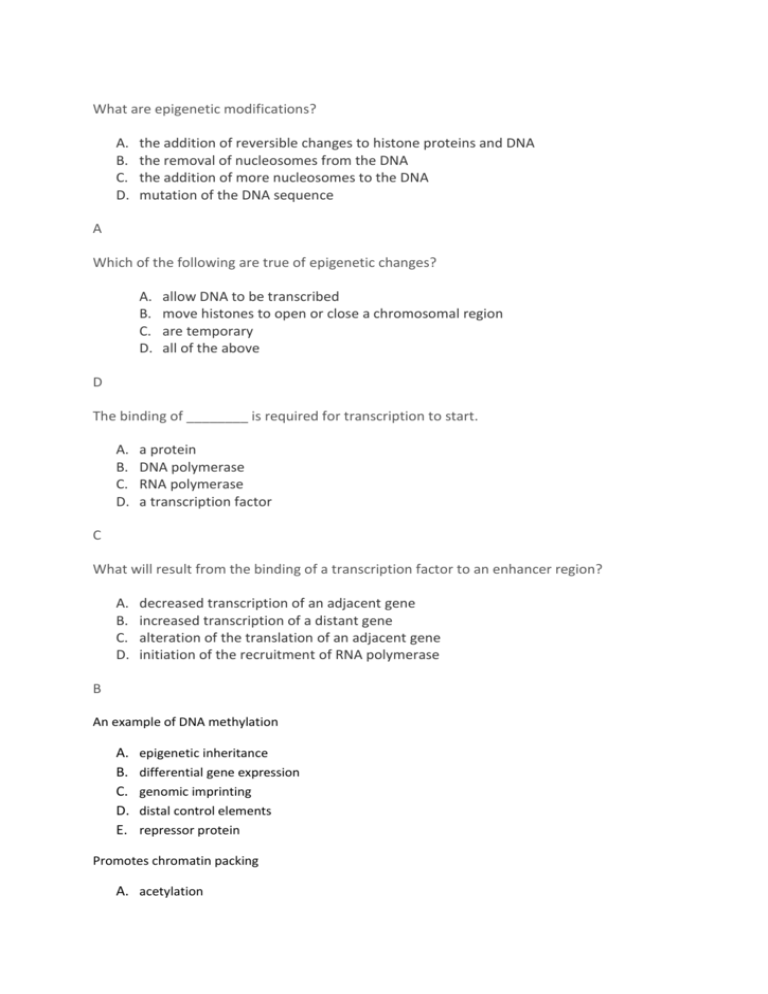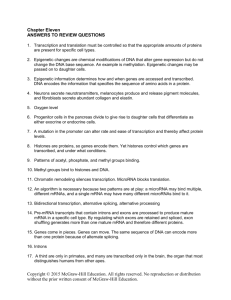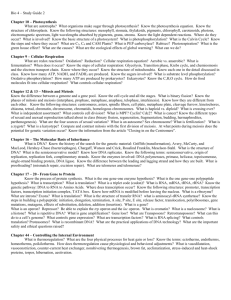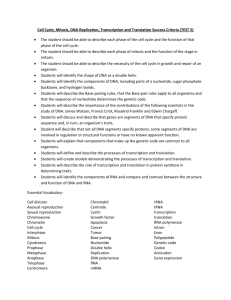Some more sample questions
advertisement

What are epigenetic modifications? A. B. C. D. the addition of reversible changes to histone proteins and DNA the removal of nucleosomes from the DNA the addition of more nucleosomes to the DNA mutation of the DNA sequence A Which of the following are true of epigenetic changes? A. B. C. D. allow DNA to be transcribed move histones to open or close a chromosomal region are temporary all of the above D The binding of ________ is required for transcription to start. A. B. C. D. a protein DNA polymerase RNA polymerase a transcription factor C What will result from the binding of a transcription factor to an enhancer region? A. B. C. D. decreased transcription of an adjacent gene increased transcription of a distant gene alteration of the translation of an adjacent gene initiation of the recruitment of RNA polymerase B An example of DNA methylation A. B. C. D. E. epigenetic inheritance differential gene expression genomic imprinting distal control elements repressor protein Promotes chromatin packing A. acetylation B. C. D. E. differential gene expression operon epigenetic inheritance methylation Inheritance of traits transmitted by mechanisms not directly involving the nucleotide sequence. A. B. C. D. E. genomic imprinting epigenetic enhancers transcription factors eukaryotic transcription Enzymes attach acetyl groups to positively charged lysines in the histone tails A. B. C. D. E. acetylation methylation corepressor imprinting splicing Constitutive genes A. Are always "off" in all environmental conditions. B. Are among the most important elements of a cell's genome, C. Control the ability of DNA to replicate, express itself, and repair itself. D. Control protein synthesis and much of an organism's central metabolism. Differences between types of cells in an organism A. are because of expression of different sets of genes. B. Are usually because of different types of DNA C. Only happen with X-inactivation Histones are A. The least conserved proteins known B. Essential for the well-being of eukaryotes C. have considerable change in their amino acids D. Can be modified, especially the positively charged amino acids What is a histone code? What usually would cause a gene to be turned on. A. modifications of the histones' positively charged amino acids to create some domains in B. C. D. E. which DNA is more open. modifications of the histones' positively charged amino acids to create some domains in which DNA is very tightly bound up. DNA methylation Small noncoding RNAs Acetylation of the tails of histone molecules Specific proteins, called transcription factors, bind to specific DNA sequences if the DNA is open and accessible. These have at least two domains: A. B. C. D. Effector domain Zinc finger domain DNA binding domain Microarray domain Imprinting is A. B. C. D. Activation of non-transcribing genes Methylated DNA Silencing of one of the two alleles of a gene Loss of telomeres during development. Chromatin remodeling A. Involves opening the chromatin at specific places B. Is not important for the functioning of eukaryote cells C. Can involve different types of histones D. Involves protein complexes Remodeler protein complexes A. B. C. D. All use ATP stop the nucleosome from moving during remodeling expose DNA to regulatory factors binds approximately 40 base pairs outside the nucleosome What is a CpG group? Why is important in epigenetics? Which is true? A. B. C. D. Methylation of histones always increases transcription. Acetylation of histones always increases transcription. Methylaion of histones sometimes increases and sometimes decreases transcription. Methylation and acetylation do not change transcription.






